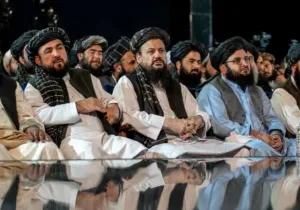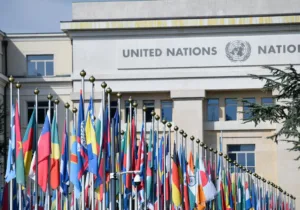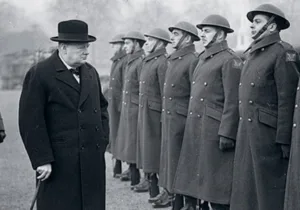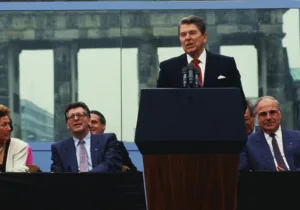At once looking back upon the totalitarian horrors she and many of her scholarly kind had abhorrently witnessed, but also forward to an increasingly uncertain world marked by unprecedented destructive possibilities, Hannah Arendt writes in On Revolution (1963), “Wars and revolutions… have thus far determined the physiognomy of the twentieth century. And as distinguished from the nineteenth-century ideologies… war and revolution still constitute its two central political issues… This most certainly will remain a century of revolutions” (1, 8). In response to the astonishing fall of Kabul and sudden capitulation of the Afghan government, President Joe Biden ordered Operation Allies Welcome on August 29, entrusting to the Department of Homeland Security the mission “to support vulnerable Afghans, including those who worked alongside us in Afghanistan for the past two decades, as they safely resettle in the United States… [with] the goal of bringing to the United States Afghan nationals who worked for the United States.” The same assortment of official statements also records the resolution of General Glen D. VanHerck to do all in his power on behalf of “our Afghan guests.” The subsequent communiqué of Secretary Alejandro Majorkas of September 3, meanwhile, is more specific, explaining, “Operation Allies Welcome is the ongoing effort to bring Americans home, and to bring vulnerable Afghans to the United States… [including] US citizens, lawful permanent residents, Special Immigrant Visa holders, individuals who have assisted the United States in Afghanistan, and all other vulnerable Afghans, such as journalists and vulnerable women and girls.” After successful arrival, inspection, and processing at the Washington Dulles or Philadelphia airports, it is furthermore explained that passengers are then to be transported to temporary housing at one of eight Defense Department bases, forts, or camps.
Although allowance ought certainly to be made for imprecise utterance amid international emergency, careful parsing of the above official statements leaves one perplexed. To work alongside is different from to work for, and a worker of any kind is categorically different from a guest. American citizens possess the legal, and vulnerable Afghans might advance the moral right of entry-for-settlement in the United States, but neither constitute allies in any legal or diplomatic sense of the term. The legal justification for the airlifting to America of the at least forty-nine thousand human subjects of this operation is by no means to be considered merely an irreverent offhand remark at the foot of the newly minted tomb of the Islamic Republic, but rather unites every permutation and vicissitude of 20 years of Afghan war and revolution; and the following question is therefore posed: In what sense was Afghanistan ever allied to the United States?
Neither the Charter of the United Nations and Statute of the International Court of Justice (1945), the Geneva Conventions (1906–07, 1949) codifying the laws of war, the Vienna Conventions (1961–86) outlining the diplomatic protocols of peace, nor any other international law instrument clearly defines alliance; and the establishment of its presence or absence therefore belongs to the general usage of nations. The point of departure for the subject matter is recognition of the overarching principle of customary international law whereby a treaty is signed by a contracting plenipotentiary and then ratified by the domestic organ competent to create law, which among democracies is the national assembly or parliament. The American Constitution of 1789 furnishes the first historic example, whereby the president “shall have Power, by and with the Advice and Consent of the Senate, to make Treaties, provided two thirds of the Senators present concur” (II.2). The first historic attempt at legal alliance failed, through the implosive sequence of events whereby the Treaty of Peace with Germany was signed at Versailles on June 28, 1919, but was laid aside without action by the Senate Foreign Relations Committee the following February. The Versailles Treaty containing the Covenant of the League of Nations was based on action by the “Allied and Associated Powers,” and thus its primary objective as conceived by President Woodrow Wilson was to create a peacetime alliance within intersecting comparative and international law to formally succeed the victorious but non-binding wartime Entente. Thirty years later, the second presidential attempt at alliance succeeded through the decisive North Atlantic Treaty, in which the “Parties” dedicate themselves to “collective defense,” primarily through the provision (5) that any armed attack upon any one of their respective homelands shall be regarded as an attack upon those of all the other parties. In what was probably Dean Acheson’s construction of the terms of the Constitution, the said Secretary of State signed the treaty in Washington on April 4, the Senate “did advise and consent to the ratification of the said Treaty” on July 21, and President Truman ratified on July 25 prior to entry into force on August 24, 1949; and consultation of the archival version reveals that each step was originally published under separate cover in order to publicly demonstrate conformity to the terms of the American Constitution. The treaty-making process of the Afghan Constitution of 2004, meanwhile, largely corresponded to prevailing norm, in that presidential signature followed by National Assembly approval resulted in treaty ratification (90.5, 94).
With these legal contexts established, the diplomatic instruments governing the American relationship to Afghanistan may be newly examined. Opening with a perhaps revealingly neoliberal Trade and Investment Framework in 2004, the Obama administration formalized bilateral ties with a Strategic Partnership Agreement (2012) and a Security and Defense Cooperation Agreement (2014), with a NATO Status of Forces Agreement largely reproducing the terms of the latter. The 2012 agreement departs from the statement in November 2011 of the omnipotent Loya Jirga—the Afghan constitutional convention, in essence—designating the United States as a “strategic ally of the people and government of Afghanistan,” language binding upon Afghanistan but obviously not upon the United States. The same agreement designates Afghanistan a “Major Non-NATO Ally” (III.3), a previously unknown category. Most of the other terms of these agreements delineate the freedom of physical and legal movement and rules of engagement for the foreign armies and contractors present, although space prohibits pursuit of the intersecting problem of whether the North Atlantic Treaty confers the juridical personality required to negotiate its own agreements in this manner.
President Donald Trump, soon after his surprise election victory, adopted a different approach, outlining in a major speech at Fort Myer, Virginia, on April 21, 2017, that the American “partner and friend” to Afghanistan may now be expected to employ a conditions-based rather than a time-based withdrawal. Three years thereafter, his administration ignored the Afghan government entirely by signing at Doha on February 29, 2020, an astonishing “Agreement for Bringing Peace to Afghanistan between the Islamic Emirate of Afghanistan which is not recognized by the United States as a state and is known as the Taliban and the United States of America,” the terms of which completely invalidate those of the executive agreements of his predecessor. Within 14 months, the American government is to withdraw “all military forces of the United States, its allies, and coalition partners, including all non-diplomatic civilian personnel, private security contractors, trainers, advisors, and supporting services personnel,” ending forever the Western military and civilian presence in Afghanistan. Taliban personnel are also to be removed from international sanctions registers. In exchange, the de facto Islamic Emirate agrees to comprehensively eradicate all present or future national security threats to the United States from the territory under its control, as the two sides subsequently seek “positive relations with each other” (III.2), language whereby the Trump administration effectively switched sides in the war.
The above examination furnishes the following overall conclusion, respectfully submitted by one who neither served nor fought in the 20 years’ Afghan war. Above all, the Islamic Republic of Afghanistan never actually was an American ally, because the United States Senate never gave advice and consent to the ratification of a treaty to that effect. This comparative and international legal ambiguity has numerous important implications. Above all, succeeding presidents could on their own authority alter or abolish the policies—not laws—of their predecessors, given that their non-constitutional “executive agreements” do not bind succeeding administrations. This adjustable character of the American commitment, second, almost certainly entered into the calculations of the historically vacillating tribes that the Taliban would ultimately prove more committed and trustworthy. The absence of formal alliance, depending on the precise wording, could also affect the constitutionality of the numerous military orders and of executive directives devoted to what was an armed humanitarian exfiltration, rather than a military operation pursuant to any treaty obligations. The ultimate outcome of the fictitious Afghan alliance thus furnishes the latest tragic example of the potential consequences of the departure from constitutional procedure of imperial presidency.






 Sponsor a student for Christianity & National Security 2024
Sponsor a student for Christianity & National Security 2024